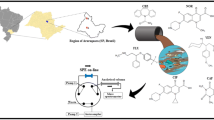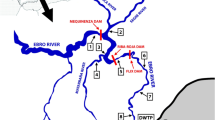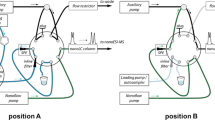Abstract
A fast and sensitive monitoring method for trace pharmaceuticals in the environment is vital because many of these compounds are ubiquitous, persistent, and biologically active with recognized endocrine-disruption and pharmacological functions. A rapid and reliable ultra high-performance liquid chromatography combined with tandem mass spectrometry was developed in the present study to simultaneously identify, confirm, and quantify 60 target pharmaceuticals in wastewater samples. The method uses a sub-2 µm particle column for separating target compounds, which were subsequently quantified with the mass spectrometer. Using this high-throughput analysis method, a single injection could provide results within 5 min for the pharmaceuticals. All of the target compounds were analyzed by the multiple-reaction monitoring with 15-ms fast polarity switching. Both intraday and interday precision analyses indicate excellent coefficient of variability. To evaluate the performance of the method, a standard solution (100 and 1000 ng L−1) was spiked into complex wastewater samples. The tailing factor and peak width were also monitored and adjusted for optimizing peaks from the ultra high-performance liquid chromatograph. Of the target pharmaceuticals in wastewater of a sewage-treatment plant analyzed on an hourly basis, only 17 compounds were detected, and others were lower than the method detection limits. Acetaminophen, cimetidine, and iopromide were all detected at >1 μg L−1, and their concentration profiles were similar to that of a nonsteroidal anti-inflammatory drug detected in wastewater. Other noticeable pharmaceuticals were sulfamethoxazole and trimethoprim. Sources of pharmaceuticals in wastewater are briefly discussed.


Similar content being viewed by others
References
Batchu SR, Panditi VR, Gardinali PR (2014) Photo degradation of sulfonamide antibiotics in simulated and natural sunlight: implications for their environmental fate. J Environ Sci Health B 49:200–211
Brewer AJ, Ort C, Banta-Green CJ, Berset J, Field JA (2012) Normalized diurnal and between-day trends in illicit and legal drug loads that account for changes in population. Environ Sci Technol 46:8305–8314
Dallüge J, Vreuls RJJ, Van Iperen DJ, Van Rijn M, Brinkman UAT (2002) Resistively heated gas chromatography coupled to quadrupole mass spectrometry. J Sep Sci 25:608–614
Ferrando-Climent L, Rodriguez-Mozaz S, Barceló D (2013) Development of a UPLC-MS/MS method for the determination of ten anticancer drugs in hospital and urban wastewaters, and its application for the screening of human metabolites assisted by information-dependent acquisition tool (IDA) in sewage samples. Anal Bioanal Chem 405:5937–5952
Gracia-Lor E, Martínez M, Sancho JV, Peñuela G, Hernández F (2012) Multi-class determination of personal care products and pharmaceuticals in environmental and wastewater samples by ultra-high performance liquid-chromatography-tandem mass spectrometry. Talanta 99:1011–1023
Gros M, Rodríguez-Mozaz S, Barceló D (2012) Fast and comprehensive multi-residue analysis of a broad range of human and veterinary pharmaceuticals and some of their metabolites in surface and treated waters by ultra-high-performance liquid chromatography coupled to quadrupole-linear ion trap tandem mass spectrometry. J Chromatogr A 1248:104–121
Grujic S, Vasiljevic T, Lausevic M, Ast T (2008) Study on the formation of an amoxicillin adduct with methanol using electrospray ion trap tandem mass spectrometry. Rapid Commun Mass Spectrom 22:67–74
Khetan SK, Collins TJ (2007) Human pharmaceuticals in the aquatic environment: a challenge to green chemistry. Chem Rev 107:2319–2364
Kim H, Hong Y, Park J, Sharma VK, Cho S (2013) Sulfonamides and tetracyclines in livestock wastewater. Chemosphere 91:888–894
Kosma CI, Lambropoulou DA, Albanis TA (2015) Comprehensive study of the antidiabetic drug metformin and its transformation product guanylurea in Greek wastewaters. Water Res 70:436–448
Lindberg RH, Östman M, Olofsson U, Grabic R, Fick J (2014) Occurrence and behaviour of 105 active pharmaceutical ingredients in sewage waters of a municipal sewer collection system. Water Res 58:221–229
Loganathan B, Phillips M, Mowery H, Jones-Lepp TL (2009) Contamination profiles and mass loadings of macrolide antibiotics and illicit drugs from a small urban wastewater treatment plant. Chemosphere 75:70–77
López-Serna R, Petrovic M, Barceló D (2011) Development of a fast instrumental method for the analysis of pharmaceuticals in environmental and wastewaters based on ultra high performance liquid chromatography (UHPLC)-tandem mass spectrometry (MS/MS). Chemosphere 85:1390–1399
Magnér J, Filipovic M, Alsberg T (2010) Application of a novel solid-phase-extraction sampler and ultra-performance liquid chromatography quadrupole-time-of-flight mass spectrometry for determination of pharmaceutical residues in surface sea water. Chemosphere 80:1255–1260
Malchi T, Maor Y, Tadmor G, Shenker M, Chefetz B (2014) Irrigation of root vegetables with treated wastewater: evaluating uptake of pharmaceuticals and the associated human health risks. Environ Sci Technol 48:9325–9333
Petrovic M, Škrbic B, Živancev J, Ferrando-Climent L, Barcelo D (2014) Determination of 81 pharmaceutical drugs by high performance liquid chromatography coupled to mass spectrometry with hybrid triple quadrupole-linear ion trap in different types of water in Serbia. Sci Total Environ 468(469):415–428
Rand-Weaver M, Margiotta-Casaluci L, Patel A, Panter GH, Owen SF, Sumpter JP (2013) The read-across hypothesis and environmental risk assessment of pharmaceuticals. Environ Sci Technol 47:11384–11395
Schwarzenbach RP, Escher BI, Fenner K, Hofstetter TB, Johnson CA, von Gunten U et al (2006) The challenge of micropollutants in aquatic systems. Science 313:1072–1077
Schymanski EL, Jeon J, Gulde R, Fenner K, Ruff M, Singer HP et al (2014) Identifying small molecules via high resolution mass spectrometry: communicating confidence. Environ Sci Technol 48:2097–2098
Shaaban H, Górecki T (2015) Current trends in green liquid chromatography for the analysis of pharmaceutically active compounds in the environmental water compartments. Talanta 132:739–752
Tölgyesi Á, Sharma VK, Fekete S, Lukonics D, Fekete J (2012) Simultaneous determination of eight corticosteroids in bovine tissues using liquid chromatography-tandem mass spectrometry. J Chromatogr B: Anal Technol Biomed Life Sci 906:75–84
United States Environmental Protection Agency (1984) Definition and procedure for the determination of the method detection limit, Appendix B to 40 CFR Part 136: Guidelines establishing test procedures for the analysis of pollutants. USEPA, Washington, DC
United States Environmental Protection Agency (2007) Method 1694: Pharmaceuticals and personal care products in water, soil, sediments, and biosolids by HPLC/MS/MS. EPA-821-R-08-002. USEPA. Washington, DC
Velagaleti R, Burns PK, Gill M, Prothro J (2002) Impact of current good manufacturing practices and emission regulations and guidances on the discharge of pharmaceutical chemicals into the environment from manufacturing, use, and disposal. Environ Health Perspect 110(3):213–220
Wang C, Gardinali PR (2012) Comparison of multiple API techniques for the simultaneous detection of microconstituents in water by on-line SPE-LC-MS/MS. J Mass Spectrom 47:1255–1268
Wode F, van Baar P, Dünnbier U, Hecht F, Taute T, Jekel M et al (2015) Search for over 2000 current and legacy micropollutants on a wastewater infiltration site with a UPLC-high resolution MS target screening method. Water Res 69:274–283
Yu K, Li B, Zhang T (2012) Direct rapid analysis of multiple PPCPs in municipal wastewater using ultrahigh performance liquid chromatography-tandem mass spectrometry without SPE pre-concentration. Anal Chimica Acta 783:59–68
Acknowledgments
This work was supported by the 2013 Research Fund of the University of Seoul.
Author information
Authors and Affiliations
Corresponding author
Electronic supplementary material
Below is the link to the electronic supplementary material.
Rights and permissions
About this article
Cite this article
Hong, Y., Sharma, V.K., Chiang, PC. et al. Fast-Target Analysis and Hourly Variation of 60 Pharmaceuticals in Wastewater Using UPLC-High Resolution Mass Spectrometry. Arch Environ Contam Toxicol 69, 525–534 (2015). https://doi.org/10.1007/s00244-015-0214-z
Received:
Accepted:
Published:
Issue Date:
DOI: https://doi.org/10.1007/s00244-015-0214-z




